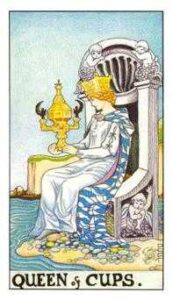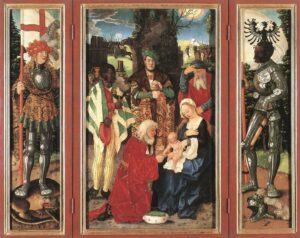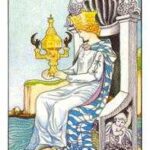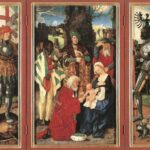In the history of humankind the differentiation of man and woman belongs among the earliest and most impressive projections of opposites, and early humankind took the male and the female as the prototype of opposites in general. Erich Neumann, The Origins and History of Consciousness
So far in this series I’ve written about three qualities of the Epoch II ego: a preference for masculine values; dualistic, either/or thinking; and repression of disliked qualities in oneself. A fourth distinguishing factor of Epoch II is conflict between pairs of opposites. A major conflict experienced by almost every Epoch II is between masculinity and femininity. All these qualities go into the formation of our God-images.
For as long as I can remember I’ve struggled with the idea that God is a male. Many spirit persons don’t think of God as a supernatural gendered being, but many ordinary people do. Everywhere we turn, religious language still speaks of He or Him and tells us we are His. As a child I found this curious. By midlife I was finding it annoying. Now I think it’s just plain silly, because this way of thinking limits our ability to open to all we are and what the Mystery really is about.
Still, there are levels of spiritual awareness. And there are times when describing the Mystery in terms of gender can be helpful, as it was for our early forbears. When it comes to seeing our assumptions and biases, it still is. To that end, I offer two lists: one for concepts associated with the “Feminine Principle” and another for the “Masculine Principle.”
I put these terms in quotes because I might as easily say the “so-called” feminine and masculine principles. Of course there are males and females, but both physically and psychologically many people find themselves somewhere between the two. Some feel like one gender living in the body of the other. Some have physical attributes associated with both genders. And we all have psychological attributes associated with both genders.
In Part II of this series I noted that we can associate the instinct, or drive, for self-preservation with the “masculine” striving for knowing, competing, and individuating, and the drive for species preservation with the “feminine urge toward relating, creating, reproducing, and evolving”. As psychologist and philosopher Eric Neumann noted in the quote above, people broadly accept this basic polarity and use the terms “masculine principle” and “feminine principle” as metaphors or category heads under which to classify all phenomena. The terms persist because they serve a useful purpose. In her book Androgyny, Jungian analyst June Singer agreed. She wrote that they symbolically express “the energic power behind all of the other polarities.”
This is the basis for my lists, using these terms as metaphors for pairs of opposites in every psyche. None of the qualities at either pole is inherently good or bad, but any of them can be taken to negative extremes if we obsess over it and repress its partner. All have positive value for both genders—whether you are a female or a male you have the potential to develop every quality listed.
The associations I give for masculine and feminine have generally held sway in mainstream Western thinking for two millennia; but earlier, and in other parts of the world now, we find many differences. For example, while Westerners today usually associate the sky with masculinity and the earth with femininity, ancient Egyptians symbolized the sky as the goddess Nut and the earth by the god Geb. Likewise, whereas traditional Tibetan Buddhism sees compassion as a masculine virtue and wisdom as feminine, the current Western trend is toward the opposite associations.
Such anomalies prove my point about the metaphorical value of the terms. The sky is no more literally masculine than the earth is literally feminine, and both genders are equally capable of being wise and compassionate. Epoch III thinkers know this and lose the need for such classifications. But associating phenomena with masculinity and femininity can be helpful in our Epoch II efforts to better understand ourselves and our ideas about God. It provides a basis to help explore the truth of our opinions and discover philosophical contradictions and solutions. Developing this dialectical ability is crucial to our psychological and spiritual maturity.
DRIVE FOR SPECIES PRESERVATION DRIVE FOR SELF PRESERVATION
Feminine Principle Masculine Principle
Relationship Individuality
Connection Separation
Shared Authority Hierarchical Authority
Intimacy Distance
Being Doing
Fertility Production
Receptivity Penetration
Emotion Logic
Instinct Reason
Nature Science
Mystery Clarity
Dark Light
Image Word
Holism Polarity
Chaos Stability
Heart Head
For more examples see pp. 50-52 of Healing the Sacred Divide.
Do some of these associations bother you? Which ones? Why? Remember, you contain the opposite qualities as well.
Art Image by Michael Cheval. Delighted by Light.
Jean Raffa’s The Bridge to Wholeness and Dream Theatres of the Soul are at Amazon. Healing the Sacred Divide can be found at Amazon and Larson Publications, Inc. Jean’s new Nautilus Award-winning The Soul’s Twins, is at Amazon and Schiffer’s Red Feather Mind, Body, Spirit. Subscribe to her newsletter at www.jeanbenedictraffa.com.




14 Responses
Hi Jean,
I enjoy your comments very much and I am trying to envision how Dr. Jung would relate to our world of today. I wonder what he would have to say about all of the focus and controversy about the Transgender issues? I wonder if he would use Twitter? LOL.
Your comments about Gods and Goddesses reminded me of the importance he put on the Assumption of Mary as part of the Godhead in 1950. He felt that this change in Catholic Doctrine was a huge evolutionary step forward in consciousness. I wish he were here today to guide us through these extraordinary times.
Thank you for all of your valuable work!
Dick Masek
Hi Dick,
Thanks for your comments and observations.
I’ve often wondered what Dr. Jung would think of us now too. I can’t imagine him using Twitter! Or spending much time at all on Social Media. I think he’d use the internet mostly for communication and serious research and save the rest of his time for his creative work, family, and clients.
As for transgender issues, his time and place was so orthodox and conservative that his ideas were mocked and considered very radical. As were Jesus’s, of course. I think if he’d been born in our times and seen all the changes and progress we’ve made since then in terms of growing self-awareness and opening up to all kinds of otherness, he’d still be way ahead of most of us. I think he’d be very accepting and hopeful. I like to think so.
I wish he were here today too. I’d so love to hear what he’d have to say. I’d go to him for analysis in a heartbeat if he’d have me!
Thank you so much for your affirmation of my work.
Jeanie
Dear Jeanie,
Thank you so much for sharing the third part of this wonderful series and most especially your lists! The titles of which say it all really, the need for ‘self-preservation’ versus the need for species preservation and the difference between them. In particular, I love that you place ‘dark’ and ‘chaos’ on the left, the feminine, and ‘light’ and ‘stability’ on the right, the masculine.
Oh, the ab-soul-utely wonderful painting, ‘Delighted by Light’ by Michael Cheval hasn’t passed me by either, a true marriage of the Divine Feminine and Divine Masculine coming together! Cheval’s attention to detail and symbolism is sublime, filled with truth, wisdom and insight as his symbolic masculine light bulbs and feminine dices come together at the table of life.
Love and light,
Deborah
Dear Deborah,
I was so excited when I discovered Sabina Spielrein’s terms “species preservation” and “self-preservation” for the feminine and masculine principles many years ago. They’ve been described in many ways throughout history—Eros/Logos, Yin/Yang, and so on—but for me, these come closest to describing the fundamental polarities of nature whose ongoing complementary partnership creates and perpetuates evolving life from atom to amoeba, ocean to whale, tree to homo sapiens, unconsciousness to wisdom. We humans seem to think we’ve reached the peak of evolution, but how can that be when we’re so happily and ignorantly destroying our own home, our Mother Earth who bore us?
Please excuse the philosophizing, but I’ve just finished the most extraordinary book, “The Overstory”, by the Pulitzer Prize and National Book Award-winning Richard Powers. It’s got me seeing a much bigger picture than usual.
I agree. Cheval is hard to beat when it comes to using visual symbolism to depict fundamental truths of life, like the ones you mention: light and dark, chaos and stability. You might say he’s the Carl Jung and Albert Einstein of contemporary art!
Love and light,
Jeanie
Oh, I ab-soul-utely loved, “The Overstory” too, which deserves many rereads! I shall add it to my reading tower of books as I continue to wander Ancient Greece, hand-in-hand with Medusa. I heart Cheval’s art!
Sounds like you’re keeping very interesting company in your travels!! How do you do that without making eye contact? 🙂
As I observe and read both rows, I’d pick one before another, but I would rather take all and mix them together to find the balance, as I recognise them as a goal to reach the wholeness, the self. 🙏💖
You and I are alike in that respect, Aladin. Thank you for writing. Blessings, Jeanie
Always the opposites….. thanks jean
Also June singer -androgyny. Thrift books has it
Hi Mark, it’s good to hear from you. Yes, always the opposites. Here’s a quote from Jung that I like: “All opposites are of God, therefore man must bend to this burden; and in so doing he finds that God in his “oppositeness” has taken possession of him, incarnated himself in him. He becomes a vessel filled with divine conflict.”
I was lucky enough to find Androgyny in the early 90’s. Back when so many wonderful books by Jungian analysts were being published. I miss those days.
Best, Jeanie
I love your list Jeanie. Thank you. I’m reminded of a discussion after a recent qi gong meet. I like our teacher so much. But he is firm in his stance of light being the source of it all. I said about the moon and her mystery – I let it go.
I hope you had a happy Mother’s Day.
Love, Susan
Hi Susan. How interesting. The fact that your qigong master sees light as the source of everything is odd. It contradicts the Chinese philosophy of yin/yang (upon which qi gong and tai chi are based) as the complementary dualities of light and dark (and their related philosophical and linguistic qualities such as feminine and masculine) as the basis for the balance of all life. I wonder if his thinking may come from a religious bias. Or maybe a gender bias — in Taoism, the sun and its light are masculine. Or maybe even physics? Well, whatever the reason, letting it go seems to be a wise choice on your part. I imagine you’re taking his class for physical and mental well-being, not philosophical conflict and debate! 🙂 I had a wonderful Mother’s Day. Thank you. Is that celebrated in South Africa? Love, Jeanie
A lovely Mother’s Day thanks Jeanie! Cold, but all warmed by being together!
I don’t think my qi gong teacher spoke from any religious stance. He’s so aware in everything but pretty firm on light being the source of all. I said about sun being solar and masculine, the moon Eros and feminine – and her power of the tides of the sea, her waxing and waning and and and – 😄
Well then, you and he simply have different opinions! I had a professor once who loved to say, “Let’s agree to disagree.” 🙂